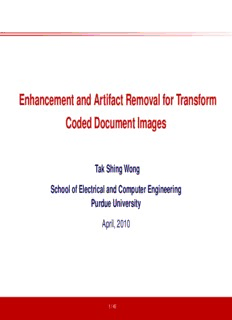
Enhancement and Artifact Removal for Transform Coded Document PDF
Preview Enhancement and Artifact Removal for Transform Coded Document
Enhancement and Artifact Removal for Transform Coded Document Images Tak Shing Wong School of Electrical and Computer Engineering Purdue University April, 2010 1/45 Outline l Overview F The problems with JPEG decoding. F Rational and related works. l A document image model and estimation algorithm for optimized JPEG decompression[1]. F A Bayesian reconstruction approach. F A document image is partitioned into 3 classes: background, text, and picture. F Each class is characterized by a specific prior model for improved decoding quality. l Optimized JPEG decoding of document images using soft classification. F A purely post-processing approach. F No segmentation is needed. F Introduced the Hypothesis Selection Filter (HSF) as a new approach for image enhancement. [1] Tak-ShingWong,CharlesA.Bouman,IlyaPollak,andZhigangFan,“ADocumentImageModelandEstimationAlgorithmforOptimizedJPEGDecompression,” IEEETransactionsonImageProcessing,vol. 18,no. 11,pp. 2518-2535,Nov. 2009. 2/45 TheProblemswithJPEGDecoding Original JPEGencodedanddecoded l JPEG encoding is lossy and leads to severe image artifacts. l Loss of high frequency content causes ringing artifacts, as apparent in the text region. l Loss of low frequency content causes blocking artifacts, as apparent in the sky region. l These artifacts are inconsistent to human interpretation, thus they are easily noticeable. 3/45 RationalandRelatedWorks l Rational: F In practice, JPEG is also commonly used with document images. F JPEG is still superior in simplicity over the more advanced schemes, e.g. JPEG 2000, DjVu, MRC. l Objective: F Assume document images are compressed by the traditional JPEG encoder. F Improve the decoding quality of any such JPEG-compressed document images. l Important, related approaches which aim at natural images: F Projection onto convex sets[1,2] F Bayesian reconstruction[3] F Adaptive post-processing[4] l Relatively few works focus on document images. [1] A.Zakhor, “Iterativeproceduresforreductionofblockingeffectsintransformimagecoding,” IEEETransactionsonCircuitsandSystemsforVideoTechnology, vol. 2,no. 2,pp. 91-95,Mar. 1992. [2] Y.Yang,N.Galatsanos,andA.Katsaggelos,“Regularizedreconstructiontoreduceblockingartifactsofblockdiscretecosinetransformcompressedimages,”IEEE TransactionsonCircuitsandSystemsforVideoTechnology,vol. 3,no. 6,pp. 421-432,Dec. 1993. [3] T. O’Rourke and R. Stevenson, “Improved image decompression for reduced transform coding artifacts,” IEEE Transactions on Circuits and Systems for Video Technology,vol. 5,vol. 6,pp. 490-499,Dec. 1995. [4] A. Averbuch, A. Schclar, and D. Donoho, “Deblocking of block-transform compressed images using weighted sums of symmetrically aligned pixels,” IEEE TransactionsonImageProcessing,vol. 14,no. 2,pp. 200-212,Feb. 2005. 4/45 FirstApproach–ADocumentImageModelandEstimationAlgorithmfor OptimizedJPEGDecompression Background Select a color Choose the algorithm block decoding JPEG encoded image channel to decode for each image block Text/graphic Combine results Decoded block decoding DCT blocks color channel from a channel Y channel Picture block decoding C channel b (conventional JPEG) C channel r Segmentation Image block map Y channel segmentation l Segment document into regions with distinct statistical attributes F Background F Text/graphics F Picture l For each region, design a decoding strategy optimized for that content 5/45 ClassesofContent l Decompose image blocks into three classes: picture F Background n Background and smooth regions n Low AC energy n Vulnerable to blocking artifacts F Text/graphic n High density of sharp edges n Susceptible to ringing artifacts F Picture n Non-smooth part of natural images n Conventional JPEG decoding text background 6/45 JPEGDecodingasanInverseProblem l JPEG decoding as an inverse problem F Solution is non-unique ⇒ inverse is ill-posed. n JPEG quantization is a many-to-one mapping. n Many image blocks would be quantized to the same set of DCT coefficients. F Prior model should be different for background, text, and picture regions F Maximum a posteriori (MAP) estimate can be computed using optimization l Forward model for JPEG encoding y = Dx Quantizer xs DCT s s y˜s y˜ = Q(y ) s s JPEG Encoder F Probability of data is either 1 or 0 1, if Q(Dx ) = y˜ s s p(y˜ |x ) = s s 0, otherwise ( 7/45 MAPReconstruction conventional JPEG decoded block x1 y1 Q0 Q1 x˜s,1 y0 DCT (basis rotation) y˜s,0 y˜s,1 x˜s,0 x0 Spatial domain Frequency domain x˜ : i-th pixel of conventional y˜ : i-th quantized DCT coefficient s,i s,i JPEG decoding Q : i-th quantization step size i : possible estimate of x s l The MAP reconstruction of the document is given by xˆ = arg min −log p(y˜ |x ) − log p(x ) (1) s s s s xs (cid:8) (cid:9) xˆ = arg min −log p(x ) (2) s s xs:Q(Dxs)=y˜s F The forward model is a binary constraint for the estimate of x s 8/45 PriorModelforLuminanceTextBlock l Model for text F Each JPEG block consists of two predominant colors c - background color 1 c - foreground color 2 F Colors are mixed together for each pixel using an alpha channel α i x = α c + (1 − α )c + noise, 0 ≤ α ≤ 1 i i 1 i 2 i l Distribution of pixels 1 1 2 p(x|c ,c ,α) = exp − |x − α c − (1 − α )c | 500 1 2 i i 1 i 2 const ( 2σ2 ) W iinblock X 400 l The foreground and background colors of image blocks form a MRF α)s,i300 p( 200 1 1 p(c1,c2) = exp − ρ(c1,r−c1,s)+ρ(c2,r−c2,s) 100 const ( 2σ2 ) C (r,Xs)are h i 0 neighbortextblocks −30 −20 −10 α0 10 20 30 s,i where ρ(t) = min(t2,τ2) 6 5 l The alpha values are i.i.d. on interval [0,1] 4 α)s,i3 1 p( exp ν|α − .5|2 , if α ∈ [0,1] 2 i i p(αi) = const (cid:26) (cid:27) 1 0, otherwise 0 −0.5 0 α0.5 1 1.5 s,i 9/45 PriorModelforLuminanceBackgroundBlocks l Model for background blocks F Each background block is characterized by its DC coefficient F DC coefficients are modeled as a Gaussian MRF l Distribution of DC coefficients 1 1 p(x) = exp − |y − y |2 s,0 r,0 const 2σ2 (cid:16) B {r,sX}∈Kbb (cid:17) y - DC coefficient for block s s,0 10/45
Description: